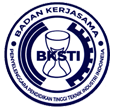Project Risks Identification of Steel Construction on Industrial Buildings : A Systematic Literature Review
Abstract
Keywords
Full Text:
PDFReferences
Al-Kawari, M. S., & Hushari, M. (2019). Doses and radiation risks estimation of adding steel slag to asphalt for road construction in Qatar. Construction and Building Materials, 228, 116741. https://doi.org/10.1016/j.conbuildmat.2019.116741
Campione, G., Lo Giudice, E., & Cannella, F. (2020). Risk of failure for the salso river railroad steel bridge. Engineering Failure Analysis, 118(June), 104887. https://doi.org/10.1016/j.engfailanal.2020.104887
Celano, F., Dolšek, M., & Žižmond, J. (2018). The Evaluation Of Risk-Targeted Safety Factors And Behaviour Factor For Selected Steel Structures. Prooceedings 16th European Conference on Earthquake Engineering, 1–12.
Dewi, D., Bastori, I., Tris Yuliyanto, A., Stankevica, K., & Soetrisnanto, A. (2020). Manufacturing Risk Identification in the Steel Industry. E3S Web of Conferences, 190, 1–11. https://doi.org/10.1051/e3sconf/202019000006
Dobiášová, S., & Kubečka, K. (2014). Risk analysis of steel construction projects documentation blast furnaces. Advanced Materials Research, 899(February 2014), 564–567. https://doi.org/10.4028/www.scientific.net/AMR.899.564
Dube, S. K; Mali, N. H. (2018). Risk Management in Steel Plants. 0869(5), 100–105.
Duncan, W. R. (2013). A Guide To The Project Management Body Of Knowledge (5 th). project managemant institute.
Dunant, C. F., Drewniok, M. P., Sansom, M., Corbey, S., Cullen, J. M., & Allwood, J. M. (2018). Options to make steel reuse profitable: An analysis of cost and risk distribution across the UK construction value chain. Journal of Cleaner Production, 183, 102–111. https://doi.org/10.1016/j.jclepro.2018.02.141
Elsanadedy, H., Alrubaidi, M., Abbas, H., Almusallam, T., & Al-Salloum, Y. (2021). Progressive collapse risk of 2D and 3D steel-frame assemblies having shear connections. Journal of Constructional Steel Research, 179(January), 106533. https://doi.org/10.1016/j.jcsr.2021.106533
Faggiano, B., Esposto, M., & Mazzolani, F. M. (2008). Risk Assessment of Steel Structures Under Fire. The 14th World Conference on Earthquake Engineering 2008, Beijing, China.
Giannetti, C., & Ransing, R. S. (2016). Risk based uncertainty quantification to improve robustness of manufacturing operations. Computers and Industrial Engineering, 101, 70–80. https://doi.org/10.1016/j.cie.2016.08.002
Harris, J. L., & Michel, J. L. (2019). Approximate Fundamental Period for Seismic Design of Steel Buildings Assigned to High Risk Categories. Practice Periodical on Structural Design and Construction, 24(4), 04019023. https://doi.org/10.1061/(asce)sc.1943-5576.0000444
Hong, Y., Wang, X., Wang, Y., & Zhang, Z. (2020). Study on reducing the risk of stress corrosion cracking of austenitic stainless steel hydraulically expanded joints. Engineering Failure Analysis, 113(November 2019), 104560. https://doi.org/10.1016/j.engfailanal.2020.104560
Hwang, J. P., Jung, M. S., Kim, M., & Ann, K. Y. (2015). Corrosion risk of steel fibre in concrete. Construction and Building Materials, 101, 239–245. https://doi.org/10.1016/j.conbuildmat.2015.10.072
Hwang, S.-H., & Lignos, D. G. (2017). Effect of Modeling Assumptions on the Earthquake-Induced Losses and Collapse Risk of Steel-Frame Buildings with Special Concentrically Braced Frames. Journal of Structural Engineering, 143(9), 04017116. https://doi.org/10.1061/(asce)st.1943-541x.0001851
Hwang, S. H., Jeon, J. S., & Lee, K. (2019). Evaluation of economic losses and collapse safety of steel moment frame buildings designed for risk categories II and IV. Engineering Structures, 201(July), 109830. https://doi.org/10.1016/j.engstruct.2019.109830
Hwang, S. H., & Lignos, D. G. (2018). Nonmodel-based framework for rapid seismic risk and loss assessment of instrumented steel buildings. Engineering Structures, 156(November 2017), 417–432. https://doi.org/10.1016/j.engstruct.2017.11.045
Jung, M. S., Kim, K. B., Lee, S. A., & Ann, K. Y. (2018). Risk of chloride-induced corrosion of steel in SF concrete exposed to a chloride-bearing environment. Construction and Building Materials, 166, 413–422. https://doi.org/10.1016/j.conbuildmat.2018.01.168
Kihira, H. (2007). Systematic approaches toward minimum maintenance risk management methods for weathering steel infrastructures. Corrosion Science, 49(1), 112–119. https://doi.org/10.1016/j.corsci.2006.05.029
Kim, M. S., Lee, E. B., Jung, I. H., & Alleman, D. (2018). Risk assessment and mitigation model for overseas steel-plant project investment with analytic hierarchy process-fuzzy inference system. Sustainability (Switzerland), 10(12). https://doi.org/10.3390/su10124780
Klöber-Koch, J., Braunreuther, S., & Reinhart, G. (2018). Approach for Risk Identification and Assessment in A Manufacturing System. Procedia CIRP, 72, 683–688. https://doi.org/10.1016/j.procir.2018.03.218
Kook, D., & Kim, S. (n.d.). An Analysis of Schedule Risk Factors of Structural Steel Work. 1241–1246.
Lagaros, N. D. (2014). Risk assessment of steel and steel-concrete composite 3D buildings considering sources of uncertainty. Earthquake and Structures, 6(1), 19–43. https://doi.org/10.12989/eas.2014.6.1.019
Lee, S. A., Park, K. P., Kim, J., & Ann, K. Y. (2020). Sensitivity analysis for binders in concrete mix to the corrosion risk of steel embedment in chloride-bearing environments. Construction and Building Materials, 251, 118944. https://doi.org/10.1016/j.conbuildmat.2020.118944
Leu, S. Sen, & Chang, C. M. (2013). Bayesian-network-based safety risk assessment for steel construction projects. Accident Analysis and Prevention, 54, 122–133. https://doi.org/10.1016/j.aap.2013.02.019
Molina Hutt, C., Rossetto, T., & Deierlein, G. G. (2019). Comparative risk-based seismic assessment of 1970s vs modern tall steel moment frames. Journal of Constructional Steel Research, 159, 598–610. https://doi.org/10.1016/j.jcsr.2019.05.012
Rad, A. R., & Banazadeh, M. (2018). Probabilistic risk-based performance evaluation of seismically base-isolated steel structures subjected to far-field earthquakes. Buildings, 8(9), 1–22. https://doi.org/10.3390/buildings8090128
Shi, F., Saygili, G., Ozbulut, O. E., & Zhou, Y. (2020). Risk-based mainshock-aftershock performance assessment of SMA braced steel frames. Engineering Structures, 212(January), 110506. https://doi.org/10.1016/j.engstruct.2020.110506
Steffens, A., Dinkler, D., & Ahrens, H. (2002). Modeling carbonation for corrosion risk prediction of concrete structures. Cement and Concrete Research, 32(6), 935–941. https://doi.org/10.1016/S0008-8846(02)00728-7
Tanner, P. (2008). Development of Risk Acceptance Criteria for the Design of Steel Structures. September, 3–5.
Yu, B., Liu, J., & Chen, Z. (2017). Probabilistic evaluation method for corrosion risk of steel reinforcement based on concrete resistivity. Construction and Building Materials, 138, 101–113. https://doi.org/10.1016/j.conbuildmat.2017.01.100
Zavadskas, E. K., Turskis, Z., & Tamošaitiene, J. (2010). Risk assessment of construction projects. Journal of Civil Engineering and Management, 16(1), 33–46. https://doi.org/10.3846/jcem.2010.03
Zehtab Yazdi, M. H., Raissi Dehkordi, M., Eghbali, M., & Ghodrati Amiri, G. (2021). Fuzzy-Based Seismic Risk Prioritization of Steel School Buildings. Natural Hazards Review, 22(1), 04020044. https://doi.org/10.1061/(asce)nh.1527-6996.0000411
Zhang, J., Ebrahimi, N., & Lai, D. (2019).Galvanic Corrosion Risk of Using Galvanized A325 Bolts in Corrosion-Resistant Steel Bridges. Journal of Bridge Engineering, 24(6), 06019001. https://doi.org/10.1061/(asce)be.1943-5592.0001395
DOI: http://dx.doi.org/10.22441/ijiem.v2i3.11895
Refbacks
- There are currently no refbacks.

This work is licensed under a Creative Commons Attribution-NonCommercial 4.0 International License.
IJIEM - Indonesian Journal of Industrial Engineering & Management
Program Pascasarjana Magister Teknik Industri Universitas Mercu Buana
Kampus Menteng - Gedung Tedja Buana, Floor 4th
Jl. Menteng Raya No. 29 Jakarta Pusat- Indonesia
Tlp.: +62 21 31935454 Fax: +62 21 31934474
http://publikasi.mercubuana.ac.id/index.php/ijiem
Email: [email protected]

This work is licensed under a Creative Commons Attribution-NonCommercial 4.0 International License.
The journal is indexed by:





1.png)
.png)
.png)
.png)







